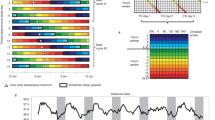Summary
In each circadian cycle, a mouse begins its major activity period with discrete wake onset and activity onset events. The precision with which these events are timed in constant darkness was analyzed using the approach outlined by Pittendrigh and Daan (1976).
-
1.
Negative serial correlations of observed circadian period values (mean r1=−0.471 for wake data, −0.409 for activity data) imply that deviations in period tend to be compensated by opposite deviations in the following cycle.
-
2.
As a result, precision of the circadian pacemaker must be better than that of observed rhythms. Standard deviation of the pacemaker periodσ(Τ) was estimated at 5.1 min. Some individual data series had estimates s(Τ)=0, implying a nearly perfect pacemaker.
-
3.
Previous speculation was that wake onset would be under more direct pacemaker control than activity onset, and would therefore be timed more precisely (Pittendrigh and Daan 1976; Richardson et al. 1985). Contrary to this prediction, intervals between successive wake onsets exhibited significantly greater variance than intervals between successive activity onsets. Two possible interpretations of this finding were proposed.
Similar content being viewed by others
References
Bartlett MS (1946) On the theoretical specification of sampling properties of autocorrelated time series. J R Statist Soc S8:27–41
Chatfield C (1975) The analysis of time series: theory and practice. Chapman and Hall, London
Kronauer RE, Czeisler CA, Pilato SF, Moore-Ede MC, Weitzman ED (1982) Mathematical model of the human circadian system with two interacting oscillators. Am J Physiol 242:R3-R17
Littel RC, Folkes JL (1971) Asymptotic optimality of Fisher's method of combining independent tests. J Am Statist Assoc 66:802–806
Ljung GM, Box GEP (1978) On a measure of lack of fit in time series models. Biometrika 65:297–303
Moore-Ede MC, Sulzman FM, Fuller CA (1982) The clocks that time us: physiology of the circadian timing system. Harvard, Cambridge, MA
Pittendrigh CS, Daan S (1976) A functional analysis of circadian pacemakers in nocturnal rodents I. The stability and lability of spontaneous frequency. J Comp Physiol 106:223–252
Priestley MB (1981) Spectral analysis and time series. Academic Press, London
Richardson GS, Moore-Ede MC, Czeisler CA, Dement WC (1985) Circadian rhythms of sleep and wakefulness in mice: analysis using long-term automated recording of sleep. Am J Physiol 248:R320-R330
Vincent FA (1978) A computer algorithm for the real-time automatic sleep state scoring of mouse electroencephalogram. Engineer's thesis, Stanford University
Wever R (1984a) Toward a mathematical model of circadian rhythmicity. In: Moore-Ede MC, Czeisler CA (eds) Mathematical models of the circadian sleep-wake cycle. Raven, New York
Wever RA (1984b) Properties of human sleep-wake cycles: parameters of internally synchronized free-running rhythms. Sleep 7:27–51
Author information
Authors and Affiliations
Rights and permissions
About this article
Cite this article
Welsh, D.K., Engle, E.M.R.A., Richardson, G.S. et al. Precision of circadian wake and activity onset timing in the mouse. J. Comp. Physiol. 158, 827–834 (1986). https://doi.org/10.1007/BF01324824
Accepted:
Issue Date:
DOI: https://doi.org/10.1007/BF01324824




